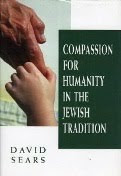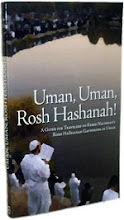Otzar Nachmani # 226
Collected Talks of Rabbi Nachman
Burstein, zatzal
Translated by Dovid Sears (unedited)
Posted in honor of Reb Avraham
Sternhartz’s yahrtzeit, 20 Elul.
[Reb Nachman
Burstein writes:]
I heard many
times from the Breslover elder (“chassid ha-vasik”), Rabbi Levi Yitzchok
Bender, zal, about the awesome power of our master, Reb Avraham “Sofer”
Sternhartz, zal, during the days of Rosh Hashanah in Uman—whether
concerning his leading of the prayers, his public teaching of Torah, or other
matters. Reb Levi Yitzchok described to us the astonishing strength of our
teacher, who was already seventy years old; for he left Uman for Eretz Yisrael
in 1936 at age 74—and he gave a mnemonic for this from the verse, “bitchu
ba-Shem adey ad … trust in Hashem forever,” which can also be read “until
74 (ayin-dalet)” [when his patient trust in Hashem’s deliverence was at
last fulfilled].
This avodah
began at the holy tziyyun of the Rebbe, zal, at chatzos
(midnight) on the last night before Rosh Hashanah—the night of the “Zekhor
Bris” selichos (petitional prayers), which is the last night of the
year. (See Sippurey Ma’asiyos, Ma’aseh 13, in the story of the Fourth
Day, which states that that when night fell, the people would weep.)
After spending
about an hour reciting Tikkun Chatzos, [Reb Avraham] went [from the
Rebbe’s tziyyun] to the Kloyz, there to imploringly lead the selichos
of “Zekhor Bris” amidst the throngs of chassidim. As soon as he intoned
the opening words, “Ashrei yoshvei veisekho,” intense feelings of awe
would grip the holy congregation. “Es is shoyn gevven a shtick Rosh Hashanah,
“It was already ‘of a piece’ with Rosh Hashanah,” [as Reb Noson used to say of
the Erev Rosh Hashanah selichos].
A large group of
Breslover chassidim still remained at the Rebbe’s tziyyun. They were
awe-struck to hear the sound of [Reb Avraham’s] voice like a mighty shofar,
as if summoning them. They immediately hastened to the Kloyz, as if in a single
breath, while the voice of our master began to echo through the interior of the
Kloyz and spread to the outside with the concluding words of each section of
the selichos—especially the end of “K-el horeisa lonu sh’losh esrei…”
when his voice waxed louder, sweetly and lingeringly, as he wept in
supplication, the tears flowing down his cheeks, as he poured out his heart
like water. And all those present answered him, the entire holy congregation
assembled in the Kloyz, “like one man with one heart,” aroused with deep emotion,
crying out in prayer with tears and entreaty, with broken-hearted sighs and
groans that rent the very heavens!
[As Reb Levi
Yitzchok said,] “Di kolos hobb’n … mamash es kekht zikh a kes’l! The
sounds had [such an emotional effect]… It was like a boiling kettle!” The
entire Kloyz became one spiritual conflagration. Amidst these holy flames, the chassidim
stood for more than three hours, until the end of selichos.
Reb Levi
Yitzchok remembered the first time he came to Uman in Elul 5674/1914, and heard
our master [Reb Avraham ] lead the selichos of “Zekhor Bris”: “Hott
mir di selichos gekling’n in di oyr’n a gantzeh Erev Rosh Hashanah. Ich hobb
nit gevist oyf velkhe ich bin… The selichos resounded in my ears the
entire Erev Rosh Hashanah. I didn’t know where I was! I had never heard
anything like this before in the world. I actually experienced what the Rebbe
said: ‘Other [tzaddikim] long for a Rosh Hashanah like my Erev Rosh Hashanah!’ The
prayers were like a fire! The sounds emanating from the Kloyz reverberated
through the surrounding area. Faces were enflamed; hearts burned; the synagogue
was engulfed by a spiritual inferno. It is impossible to describe the heart’s
passion for G-d at that time—it was truly an experience of nullification to the
Ohr Ein Sof (Infinite Light), a transcendence of physicality [as
mentioned in Tur-Shulchan Arukh, Orach Chaim 98]. It is impossible to
describe how they could stand in the middle of such a blaze, with such
heartfelt cries, almost to the point of expiry of the soul, for so many hours…”
It is
self-understood that this fervor and spiritual arousal affected the entire avodah
of Erev Rosh Hashanah—particularly the hishtatchus (prostration),
outpouring of the soul, and earnest recitation of the ten psalms of Tikkun
ha-Klalli at the Rebbe’s tziyyun.
In addition, the
magnanimous giving of tzedakah (charity) was beyond all bounds. For they
made no calculations, but simply gave profusely, with flames of love, from a
special fund they had set aside for that purpose throughout the past year. It
was a beautiful sight to behold the wondrous generosity of our brothers, the
like of which was not to be found anywhere else. (It is brought in Sefer ha-Middos that
one should give tzedakah “with both hands,” in the merit of which one’s
prayers will be heard.) And this was aside from the money given as a pidyon nefesh
(“redemption of the soul”) to prominent Breslover chassidim, as is customary,
in fulfillment of the Rebbe’s words in Sichos ha-Ran (sec. 214): “On
Erev Rosh Hashanah, one should give a pidyon.” (And I heard that during
the previous generation, they used to give a pidyon to the eminent chassid,
Reb Abale, zal, in keeping with Likutey Moharan I, 200 [end]; see
there.)
The giving of tzedakah
at the Rebbe’s tziyyun prior to reciting Tikkun ha-Klalli was
a distinct avodah. For this tzedakah was in honor of the neshamah
of the “light of our life,” the Rebbe, zal, who had said, “And give a
coin (perutah) to tzedakah for my sake,” at the time he revealed
the awesome secret of Tikkun ha-Klalli: the ten psalms designation for tikkun
ha-bris [“repair of the covenant,” spiritual correction of nocturnal emissions, which Reb Noson understood
to extend to the correction of all sins; also see Likutey Moharan I, 200 [end]; see
there.)
All day long the holy tziyyun
was resonant with the sounds of hundreds of people coming and going from the ohel
(shelter) that covered the Rebbe’s grave, which embodied the “small that
contains the great” [see the Rebbe’s story, “The Seven Beggars,” Fifth Day
(“The Hunchback”); this concept is found in the Midrash—DS]. For the ohel was
too small to hold even a minyan; yet miraculously on Erev Rosh Hashanah,
tens of people entered its holy interior, defying all comprehension.
What took place there at that time is
beyond words, given the great spiritual arousal, outpouring of the soul,
prayers, supplications, confessions, tears and screams, sighs and moans, which
reached unto the heart of heaven! It was as if one could feel with his very hands
the teshuvah, remorse and new inner resolve of each person.














No comments:
Post a Comment